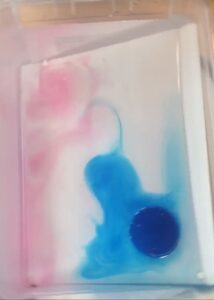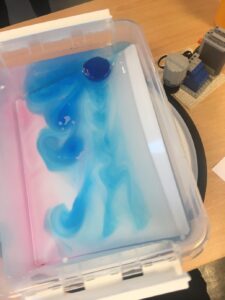I asked my students to write a “blog version” of the lab report they had to hand in as part of the course in geophysical fluid dynamics that I’m teaching this semester – below is one of them!
Planetary Rossby Waves (Written by Sigrid Vildskog & Guillaume Bonduelle)
When most people think about waves, they probably think of ocean waves crashing into the shoreline and beaches, but waves are so much more than that! In this report we are going to look at planetary Rossby waves, and how we can simulate them in the classroom.
First; what is a Rossby wave? Rossby waves are slow-moving large-scale waves that occur in rotating fluids, such as both the atmosphere and ocean. They are always propagating towards the west, due to something called vorticity and the change in the Coriolis force with latitude. The vorticity makes the fluid turn clockwise (or anti-clockwise) if it is displaced northward (or southward).
Second; what is Coriolis? Coriolis is the force that occurs when we are in a rotating system. Large-scale movement on the earth is affected by the rotation of the earth. The effect of the rotation is dependent on latitude; there is no Coriolis force at the equator, and it increases towards the poles (negative values in the southern hemisphere).
Third: How do we simulate this change in latitude in the laboratory? In the laboratory, we use rotating tables, but the rotation rate of the table (and therefore the Coriolis force) is constant, so it’s impossible to simulate any kind of latitude. Lucky for us, there are two kinds of Rossby waves: one that is dependent on changes in latitude, and one that’s dependent on changes in depth. If we look at the equation describing vorticity, we see that changes in the Coriolis parameter (i.e. latitude), and changes in depth have the same effect on the vorticity. Therefore, in our experiment, we can use a tank with a slanted bottom to simulate the planetary Rossby waves.


Our rotating table is rotating anti-clockwise, so the shallow end of the tank is “north”. We placed a dyed ice cube in the north-east corner of the tank. The cold and heavy colored water from the melting ice cube sank towards the bottom and drained down the slope of the bottom of the tank. This movement induces stretching of the colored water column, and it will start to rotate. The rotation sets up a wave, that propagates westward in the tank. The ice cube itself moves to the western side of the tank with the wave!
This experiment allowed us to see the similarities between Rossby waves and Topographic waves with our own eyes, and experience that oceanographers can simulate a large scale system with simple equipment in a small laboratory.
